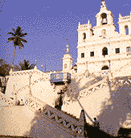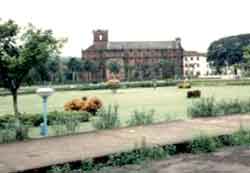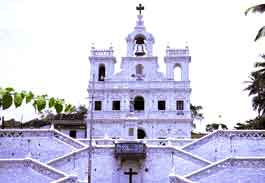| Destinations
|
||
Panaji or Panjim
 This picturesque town is the capital of Goa. Situated on the banks of the Mandovi River it retains a picturesque charm and unhurried character. Shops stay shut in the afternoon for a siesta. The Portuguese character of the town can still be seen in the old houses, cafes, bars, old churches, monuments and many administrative buildings.
This picturesque town is the capital of Goa. Situated on the banks of the Mandovi River it retains a picturesque charm and unhurried character. Shops stay shut in the afternoon for a siesta. The Portuguese character of the town can still be seen in the old houses, cafes, bars, old churches, monuments and many administrative buildings.
The principal landmark and the centre of Panaji is the Church Square and the most interesting part is definitely the Fontainhas, its oldest district. A prominent landmark is the Church of Our Lady of the Immaculate Conception. The Church dates back to 1541. A short walk brings you to the oldest surviving building in Panjim, the Secretariat, which is the seat of the State Legislature. It was originally the palace of the Muslim ruler Adil Shah in the 16th century and was later converted into the Viceroy's residence. Other landmarks in the town include The Chapel of St. Sebastian, which is famous for the crucifix that is displayed there. The State Archeological Museum is also located in Panaji. The Government of India has a Tourist Office at the Church Square. Panaji is 29 kms from the airport at Dabolim and 30 kms from the rail head at Vasco-da-Gama. |
More on Goa • Overview • History • Geography • Economy • Festivals • Wildlife • Getting Around • Climate • North Goa Beaches • South Goa Beaches Impressions • An Introduction • Barracuda |
|
Old Goa  Old Goa, 10 kms from Panaji, was the second capital of the Adil Shah dynasty but not much of that period is in evidence now. The gate of the palace of Adil Shah is the only landmark from this era which survives.The magnificent old temples, mosques and palaces were either destroyed or fell into decay during the Portuguese rule. But Old Goa retains its Portuguese character remarkably. This was the administrative capital of Goa from 1510 till 1843 after which the capital shifted to Panaji. It is now a quaint and charming village dotted with churches and convents.
Old Goa, 10 kms from Panaji, was the second capital of the Adil Shah dynasty but not much of that period is in evidence now. The gate of the palace of Adil Shah is the only landmark from this era which survives.The magnificent old temples, mosques and palaces were either destroyed or fell into decay during the Portuguese rule. But Old Goa retains its Portuguese character remarkably. This was the administrative capital of Goa from 1510 till 1843 after which the capital shifted to Panaji. It is now a quaint and charming village dotted with churches and convents.
The Se Cathedral is the largest church in Goa. Work on it started in 1562 and was more or less completed by 1619. This is a Portugese-Gothic style building and one of the original two towers is well preserved and houses the Golden Bell. The main altar is dedicated to St. Catherine of Alexandria and paintings in the cathedral depict her life and martyrdom. Apart from the main altar, the Church has eight chapels and six altars. The most visited landmark in Old Goa is the Church of Saint Francis of Assisi. The church dates back to 1661 and is built in the Baroque style. There are murals depicting the life of the saint and the floor has been constructed with many carved gravestones. There is an Archeological Museum located in the convent at the back of the Church of Saint Francis. The Basilca of Bom Jesus displays the mortal remains of St. Francis Xavier preserved in a silver casket. The construction of the Church was completed in 1605. Other churches of interest in Old Goa include The Church of St Cajetan, the ruins of the Church of St. Augustine, the Church and Convent of St. Monica. The Viceroys Arch can also be visited. Madgaon or Margao. One of the principal landmarks is the Church of the Holy Spirit which was built by the Portuguese in 1675. This is one of the finest examples of late-Baroque architecture in Goa. It has an imposing white facade and the interiors are worked with gilt, crystal and stucco. Six kilometers away is the Rachol Seminary and Church, built in 1610. Located near Raia village, the architecture of this church, is a fine blend of Christian characters in Indian styles. Its museum or art has interesting displays of antique silver, a mobile mass kit, a 17th century silver monstrance in the shape of a swan and textiles. One of the many colonial mansions in Chandor village, 20 km east of Margao, is Braganza House. It has two main wings. The west wing, Meneses Braganza House has been renovated and boasts chandeliers and stained glass windows. The east wing, Braganza Periera House displays ancient furniture and unpolished silver. The ornate private chapel and ballroom have an air of antiquity. The family happily shows you around the place for a possible donation towards renovations. Vasco da Gama
|
||
Editor: Romola Butalia (c) India Travelogue. All rights reserved. |
||

 Madgaon is the second largest town in Goa after Panaji. This capital of Salcete taluka, is a busy provincial town with distinct marks of the former Portuguese presence. It was once a major religious centre with dozens of wealthy temples and dharamsalas. Most of these were razed by the Portuguese in the seventeenth century and Catholic Churches built in their place.
Due to a large influx of migrant labour from neighbouring states the city is stretched to the limit. Margao has been an important agricultural market. Today, Margao's bazaar is a labyrinthine covered market, trading in a host of commodities from betel leaves and sacks of lime paste to baby clothes, incense, spices and cheap Taiwanese toys. It is also a place for hunting out authentic souvenirs.
Madgaon is the second largest town in Goa after Panaji. This capital of Salcete taluka, is a busy provincial town with distinct marks of the former Portuguese presence. It was once a major religious centre with dozens of wealthy temples and dharamsalas. Most of these were razed by the Portuguese in the seventeenth century and Catholic Churches built in their place.
Due to a large influx of migrant labour from neighbouring states the city is stretched to the limit. Margao has been an important agricultural market. Today, Margao's bazaar is a labyrinthine covered market, trading in a host of commodities from betel leaves and sacks of lime paste to baby clothes, incense, spices and cheap Taiwanese toys. It is also a place for hunting out authentic souvenirs.
 Situated 29 km southwest of Panaji, Vasco da Gama, was acquired by the Portuguese in 1543. Situated on the narrow western tip of the Mormugao peninsula, overlooking the mouth of the Zuari River, it is a prime shipping centre, visited by container vessels and iron-ore barges.
Storage tanks of a nearby refinery give the town a dreary, industrial look. Most tourists, pass through Vasco either to book a ticket or catch a train from the station, or while en route to the nearby Dabolim airport. Vasco is devoid of any real landmarks of tourist interest, but the Bagmalo Beach, eight km southeast is a small beach with water sports facilities and cafes.
Situated 29 km southwest of Panaji, Vasco da Gama, was acquired by the Portuguese in 1543. Situated on the narrow western tip of the Mormugao peninsula, overlooking the mouth of the Zuari River, it is a prime shipping centre, visited by container vessels and iron-ore barges.
Storage tanks of a nearby refinery give the town a dreary, industrial look. Most tourists, pass through Vasco either to book a ticket or catch a train from the station, or while en route to the nearby Dabolim airport. Vasco is devoid of any real landmarks of tourist interest, but the Bagmalo Beach, eight km southeast is a small beach with water sports facilities and cafes.